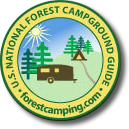Making Bug Free Moments and Memories
Next to bad weather, nothing spoils a camping trip faster than swarms of bugs. They bite, it hurts, itches, than swells, and turns red. And that is if you don’t have an allergic reaction and the insect isn’t carrying some illness like West Nile or Lyme. While there isn’t much you can do about the weather, here are some ideas collected over the years for a bug free camping trip and will help keep biting insects, specifically mosquitoes and No-see-ums, biting flies, ticks, chiggers, and ants, from spoiling your time in the forest.
Mosquitoes and No-see-ums (all so known as gnats or sand flies) are small flying insects that feed on blood. While a nuisance, usually this type of bug is not a serious threat if you are young and healthy. However, no matter your age, mosquitoes and No-see-ums are an annoyance. They are attracted to you by carbon dioxide (your exhaled breath) and sweat. So unless you can hold your breath for very long periods and know how not to sweat, a repellent that blocks the bug’s receptors is what you want. It is said the most effective repellents contain DEET at a recommended level of 30%. An alternative is the chemical repellent Picaridin. There are natural repellent on the market, such as Bite Blocker, that when applied correctly and often are also effective. (There are concerns with using DEET on small children so these natural repellents are an alternative.) Also, leave the sweet scented soap, lotions and such at home and wear clothes that blend with your skin tone. If the bugs are a problem at night, try sleeping under a mosquito net treated with permethrin. Simply, spray the netting and let dry, then drape over sleeping place.
If you didn’t get the repellant on soon enough, here are some tips on helping those bites to be less annoying and to heal. First, to stop the itch apply some with menthol, as in Vicks VapoRub. Dermatologists suggest a combination of menthol and camphor. A product called AfterBite is a personal favorite. You shouldn’t need to wash the area unless scratching has produced a wound. When you are bitten, your body releases compounds called histamines to combat the toxins in the bite. If you have a strong allergic reaction (large red lumps, excessive or extended itching) try an oral antihistamine to help the discomfort. But do not combine oral and topical antihistamines, it could cause a skin rash.
Biting flies are like mosquitoes and No-see-ums, they want your blood, but I think their “bite” hurts more. While DEET works well on mosquitoes and No-see-ums, repellents containing the chemicals R-326 and MGK-264 work better on biting flies. To treat the bites use a topical desensitizer, like AfterBite. If inflammation appears, use a hydrocortisone such as Cortaid. Some of these guys can take a rather large chunk of skin, be sure to wash such a wound and treat with a topical antiseptic ointment.
Ticks are bloodsucking parasite related to spiders and chiggers. They insert a barbed probe into the skin to feed. Gross!!! To avoid all this, and possible disease, your best defense is your clothes. Cover up as completely as possible – wear long pants tucked into your socks, long sleeve shirts and a hat. Permethrin is an effective deterrent. Spray it on your clothing, including the edges, and let dry. Its effectiveness will last for about two weeks. Avoid spraying pernethrin on skin. And check yourself careful, all over, after each sojourn into an area with ticks.
To remove a tick use tweezers, pulling straight out without twisting or turnings. Immediately, wash the bite area with soap and water and apply a topical antiseptic. Be sure to watch the area for any sign of Lyme disease, such as a bulls-eye rash, flu-like fever and aches.
Chiggers are found primarily in the southern States and can be truly miserable. Nothing itches as much as a chigger’s bite. They are so tiny you can barely see them. (A test to see if you are in chiggers territory is to slip a black piece of paper vertical into the grass. If you see tiny red or orange specks moving around on your paper, you are in chigger country.) These little brats work their way up from the ground looking for food, which could be you if you do not cover thoroughly. Wear a shirt with tight cuffs and tuck your pants into your socks. Use DEET to repel chiggers and permethrin to kill them. For your information, chiggers tend to “hang out” awhile before they start bitting, so if you have been in a chigger-prone area with out protection, take a shower and toss your clothes into the washer machine as soon as possible.
There is nothing that itches like a chigger bite – absolutely nothing! And the itching can last for days. Unlike mosquitos and no-see-ums, the itching from a chigger is caused by a toxin, injected by the critter, to help these nasty guys digest skin tissue. To treat the bites, apply hydrocortisone cream. If you have a fierce reaction and your bites become red, swollen, and painful, use a topical anesthetic and see your doctor for a prescription-strength antihistamine. Although it will be very difficult, try not to scratch as this would only aggravate the problem.
Biting ants are everywhere but the most fierce are found in the warmer states. These bugs live in colonies so all you need to do is avoid their nests. Sounds easy but if you happen to get bit, treat it right away. One homemade remedy, to apply a paste of baking soda to the area, is fairly effective. A topical anesthetics, such as lidocaine, will numb the bites and hydrocortisone should reduce the inflammation.
Camping provides many fun-filled moments and memories. Swarms of bugs can also provide lots of memories but very little fun. (Fred and I still talk about the mosquitoes swarms of Grand Mesa National Forest and the “Quarter-pounder” biting flies in the Chequamegon National Forest.) I hope these suggestions will help keep your national forest camping moments and memories itchless and pain-free.


